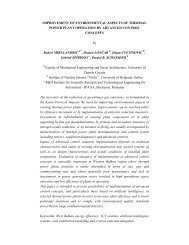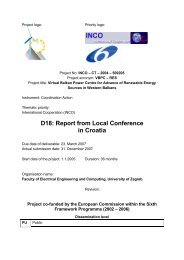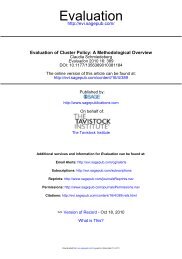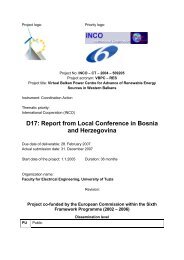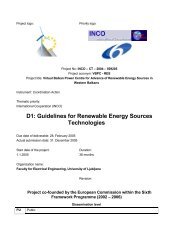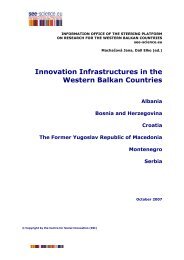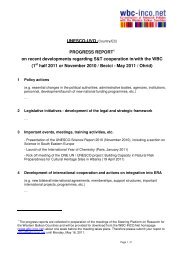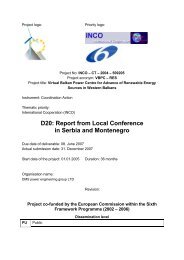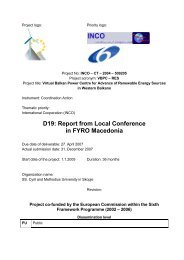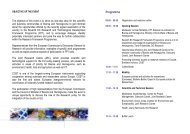Prva stran - WBC-INCO Net
Prva stran - WBC-INCO Net
Prva stran - WBC-INCO Net
Create successful ePaper yourself
Turn your PDF publications into a flip-book with our unique Google optimized e-Paper software.
c€/kWh at windy coastal locations. The electricity purchase<br />
price is crucial for WPP cost effectives.<br />
Fig. 6. Calculated costs per kWh produced using wind power<br />
IV. ENVIRONMENTAL CHARACTERISTICS OF WIND ENERGY<br />
USE<br />
As all power production facilities, wind turbines have<br />
environmental impacts, which include noise, visual impacts,<br />
atmospheric emissions during the materials processing and<br />
components production, birds’ mortality and<br />
electromagnetic interference [8].<br />
Noise from wind turbines can be of mechanical and<br />
aerodynamic origin. Aerodynamic noise is caused by<br />
interaction of the turbine blades with the surrounding air.<br />
Mechanical noise is due to the moving parts in the nacelle<br />
and it is transmitted to the environment both directly<br />
through the air and via the rest of the structure, including the<br />
tower [9]. The noise problem is the most emphasized wind<br />
turbine environmental impact. However, modern turbines<br />
are seldom heard at distances further than 300 m as<br />
background noise from wind in trees, for example, will be<br />
higher.<br />
The impact of wind turbines on visual amenity is the<br />
most controversial and difficult to quantify. In general,<br />
concern over visual impact is highest in areas of special<br />
importance and beauty and it is clear that care should be<br />
taken in the sitting and design of the turbines in other areas.<br />
Techniques for assessing visual impacts exist and are used<br />
within the planning process for wind power plants.<br />
Although there are no direct emissions to the atmosphere<br />
caused by wind turbine operation, emissions from nonoperational<br />
phases of the life cycle do exist. It has been<br />
shown that atmospheric emissions from the wind fuel cycle<br />
are insignificant in comparison to those from fossil fuels [9].<br />
The major potential impact of wind turbines on birds are<br />
collision in flight with turbines and behavioral disturbance<br />
from blade avoidance. Although numerous studies show that<br />
birds rarely collide with rotor blades this is an issue<br />
sometimes raised.<br />
The electromagnetic signals may be reflected from the<br />
turbine blades, so that a nearby receiver picks up both a<br />
direct and reflected signal. Interference occurs because the<br />
reflected signal is both delayed (due to difference in path<br />
length) and Doppler shifted (due to the blade motion).<br />
However these problems can be minimized by careful sitting<br />
of a wind facility.<br />
V. WIND ENERGY STATUS IN CROATIA<br />
Renewable energy sources have already quite large share<br />
in total energy production and total energy supply in<br />
Croatia, which is a consequence of the large share of hydro<br />
power. When it comes to electricity production, 51% of<br />
installed capacities are in hydro power plants. Apart from<br />
hydro power, there is very small share of other renewables<br />
in electricity production, as shown in Table II. In 2004 the<br />
share of RES excluding large hydro power plants was equal<br />
to approximately 0,8% of total electricity consumed.<br />
TABLE II<br />
INSTALLED RES CAPACITIES AND ELECTRICITY PRODUCTION IN CROATIA IN<br />
2004 [11]<br />
Type of RES Installed power Electricity<br />
capacity<br />
production<br />
Sun 12,74 kW 12,63 MWh<br />
Wind 5,95 MW 1,96 GWh<br />
Biomass 0 4 GWh<br />
Small hydro 26,7 MW 126,3 GWh<br />
Geothermal 0 0<br />
TOTAL 32,663 MW 132,27 GWh<br />
However, according to the Strategy of energy sector<br />
development [12], renewables will gain more significant<br />
role in Croatian energy supply and their increased use is one<br />
of the most important strategic goals of Croatian energy<br />
policy. The Strategy considers three different scenarios all<br />
characterized by the increase of RES use from<br />
approximately 75 PJ in year 2000 to 100 PJ (business-asusual<br />
scenario), 130 PJ (moderate scenario) and 160 PJ<br />
(distinctively ecological scenario) in year 2030.<br />
Wind potential assessed within the national wind energy<br />
program ENWIND in 29 locations equals to about 400 MW<br />
and electricity production capacity equals to 800 GWh per<br />
year [4]. These potentials can be exploited in Croatia in one<br />
of the following ways:<br />
On-grid installations (wind farms);<br />
Off-grid installations (hybrid systems);<br />
Water pumping, desalinization and irrigation<br />
installations.<br />
The most usually considered applications are central-grid<br />
electricity generation facilities – wind farms. Currently there<br />
is only one wind power plant in operation in Croatia – a<br />
5,95 MW wind park at the island of Pag for which a power<br />
purchase agreement has been signed by the investor and the<br />
Croatian power utility. A similar agreement has been signed<br />
for a wind power plant Krtolin near Šibenik which is yet to<br />
be constructed with a planned capacity of 5 MW as well as a<br />
wind power plant near Obrovac with a capacity of about 10<br />
MW. The interest for wind potentials exploitation comes<br />
mainly form foreign investors. However, one good example<br />
can be found within Croatian industry. Namely, Končar<br />
Group, the leading electric industry in Croatia, has a<br />
strategic goal to wider their activities to wind power. Since<br />
Končar already produces all necessary electric equipment<br />
like generators and switchgear, they have decided also to<br />
develop own wind turbine concept. It is expected that the<br />
first wind turbine prototype will be erected by the end of<br />
September 2006. In this way the completely domestic<br />
product will be developed. These aspects of RES use –<br />
creating new employment opportunities and strengthening<br />
domestic industry – are extremely important and socially<br />
beneficial, but still not emphasized strongly enough. The<br />
significant work, especially measurements ad mapping of<br />
wind potentials, has been done within ENWIND program.<br />
The program has also suggested a pilot project of 6,3 MW<br />
5



